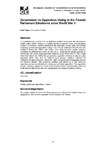Government vs opposition voting in the Finnish parliament Eduskunta since World War II

Ver/Abrir
Use este enlace para citar
http://hdl.handle.net/2183/23351Colecciones
Metadatos
Mostrar el registro completo del ítemTítulo
Government vs opposition voting in the Finnish parliament Eduskunta since World War IIAutor(es)
Fecha
2013Cita bibliográfica
Pajala, A. (2013). Government vs opposition voting in the Finnish parliament Eduskunta since World War II. European Journal of Government and Economics, 2(1), 41-58. https://doi.org/10.17979/ejge.2013.2.1.4286
Resumen
[Abstract] In a parliamentary system it is by definition justified to assume the government parties voting almost always in a unitary manner in plenary votes. In a multiparty system it is, however, hard to predict how the opposition groups vote. Few studies analysing government-opposition voting in the Finnish parliament Eduskunta were published during the 1960s and 1970s. This study provides similar analyses regarding the parliamentary years of 1991-2012. Combined the studies provide an insight into the government-opposition relations since World War II. The results show that before the 1990s the government-opposition division in plenary votes appeared rather clear and the political party groups’ positions followed the traditional left-right dimension. Since the 1990s, the government-opposition division has become greater. The governing coalition acts almost as a bloc while the opposition groups are divided into moderate and hard opposition. The opposition groups, however, appear in a more or less random order. Consequently, since the 1990s the left-right dimension has disappeared with respect to plenary voting.
Palabras clave
Voting
Parliament
Opposition
Finland
Parliament
Opposition
Finland
Versión del editor
Derechos
Atribución 4.0 España
ISSN
2254-7088






